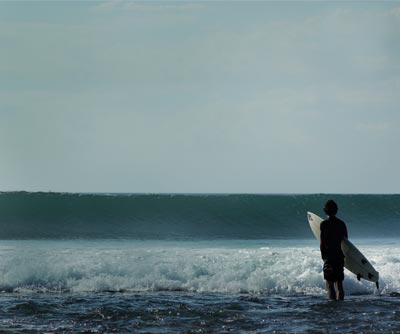
JACK KEROUAC WROTE that the teenage years are an ideal age to be introduced to the Dharma. I agree, but it can also be a complicated time. Take the summer just after high school, shortly after I’d decided to be an official, practicing Buddhist. Like many teens, I was trying to do anything possible to differentiate myself from my obviously backwards parents. Unfortunately, my parents had been practicing Buddhism from the time I was born, while I was only now falling in love with the dharma. How could I become a Buddhist without becoming them?
My rebellion was characterized by a nuanced differentiation strategy of the Karl Rove variety: I framed my parents as flaky New Age hippies with Buddhist leanings—the Spirit Rock type. I sneered at my mom’s angel books and my dad’s yoga guru, who changed his name every few months. Meanwhile, I would break free of their fluffiness and be the real deal. I would become a northern California Buddhist without a trace of hippiness, an endeavor that I now realize could be compared to living in France and shunning cheese.
The first step on my new path was finding an Asian guru, the real McCoy. I pictured three options: a gorgeous female kung fu master (think Michelle Yeoh from Crouching Tiger Hidden Dragon), who would teach me to do one-finger handstands; an old Japanese Zen master who would hit me with a stick and demand, “Jaimal!—where is your mind?”, or a Tibetan lama who could fly. I didn’t need all three. Just one would do.
My dad was very happy that I wanted to dedicate my time to spiritual goals. As a graduation gift, he enrolled me in a six-week yoga camp at the Sierra foothills ashram where we used to go as a family. I tried to get excited, but yoga camp was exactly the type of thing I was trying to avoid. The ashram was basically a burnt-out hippie commune that had replaced drugs with aggressive breathing exercises. Doing yoga every morning with a bunch of other white kids whose parents were like mine was just what I didn’t want. I needed the real thing, dammit: snow, ancient Chinese characters, disgustingly bland food.
But not accepting the gift from my dad seemed, well, un-Buddhist. So I went to yoga camp and actually had an okay time. I learned to touch my toes and stand on one leg for a very long time; I blessed people with Sai Baba’s holy water. But the real highlight was the fact that I made two dear friends: a Sicilian-American with a caveman’s beard and a ponytail who I’ll call Robert; and Gene, a quiet, witty Seattle native who had read every book I’d ever heard of.
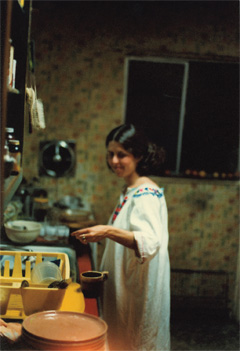 |
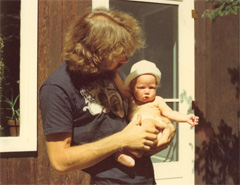 |
| Top: Jaimal’s mom in 1979, shortly before he was born; Bottom: Jaimal’s dad and his sister, Ciel |
Rob and Gene were American spiritual practitioners who were trying to avoid being hippies. Unlike the other yoga campers, they didn’t sing folk songs or greet strangers with hugs and they only used the word “love” except in the most divine of contexts. They wanted to learn Sanskrit and live in caves and generally inflict pain on themselves. Of course, it was a little embarrassing to us that three hardcore guys like us had met at a fluffy yoga camp, but as the summer continued, we chalked it up to a mere prelude to the main event. Sure, we didn’t know what that main event would be. But we knew it would be epic.
One day, over a lunch on a grassy knoll, we compared spiritual centers and teachers. Rob and Gene were both older and more experienced than I was, and I listened intently as they described Thai forest monasteries, Tibetan lamas, and other, “more authentic” yoga retreats. There was a distinct sense of competition in their excited voices, and Rob’s story won the prize.
Before yoga camp, Rob had been living at an orthodox Chinese Buddhist monastery, studying Ch’an, the Chinese precursor to Japanese Zen. “I hesitate to even talk about it,” Rob said, rubbing his beard. “I’m telling you, these monks scare me.” Gene and I settled in on the grass, letting Rob know that we were ready for the tale.
Rob shook his head and laughed as his mind churned through memories of this apparently dark place. “They sleep in cells,” he said, “in full lotus. I kid you not, the monks and nuns never lie down. They have vows to never touch their ribs to the floor or the bed.” I pictured a prison full of monks chained to the wall, their limbs contorted, and shuddered. “In winter, they meditate for fourteen hours a day. They fast for weeks at a time. The abbot sits down at noon to meditate, and he doesn’t get up until noon the next day. He’s completely still, probably in the fourth dhyana heaven, at least. Every day they chant: ‘We are like fish in a shrinking pond. What joy is there in this? We must cultivate like our heads are at stake.’ I’m telling you, it’s more Chinese than China.”
“What’s it called?” Gene asked.
“In Mandarin, it’s called ‘Wan Fo Chan.’ In English, ‘The City of Ten Thousand Buddhas.’”
Half of me felt nauseated. I was still trying to learn to sit Indian style for thirty minutes without my legs falling asleep. But the other half was elated. A place “more Chinese than China” might be just what I needed to say goodbye to my hippie roots for good.
Yawning and stretching his arms, Rob casually mentioned that The City of Ten Thousand Buddhas had an upcoming retreat we could attend—“you know, if you think you’re ready for that sort of thing.”
If I was ready? Please. This was not a challenge that could be turned down. Gene and I decided that we wouldn’t just visit the City of Ten Thousand Buddhas; we would walk there—a pilgrimage. “That sounds proper,” Rob said, when he heard our plan. “I might just join you.” But by the time the end of yoga camp rolled around, Rob had conveniently fallen for a cute massage therapist at camp. He said he needed to spend a week seeing what their karma was. She wanted to try tantric sex, and we all agreed this was an opportunity that shouldn’t be passed up.
UKIAH—THE REDNECK, pothead town that is home to the City of Ten Thousand Buddhas—was about two hundred miles from my mom’s house in Sacramento. On day one, Gene and I walked twenty miles along Highway 80 in 110-degree heat. We passed massive supermarkets, huge malls with full parking lots, and dozens of gas stations. “This is America,” Gene said. “This is where we come from.” It was ugly, true. But as I saw it, we were the remedy. Pilgrimages like this that would show people the way out of this mess. We were the ones we’d been waiting for.
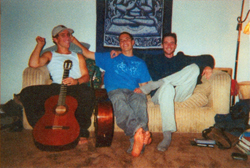 That night, we slept behind a used car lot in Davis, which seemed like perfect preparation for the kind of austerities we anticipated. I kept thinking that what we were doing wasn’t rigorous enough, so I tried not to eat much. The fourth day, we ran out of water with no cars or gas stations in sight. Then we found a mountain spring where we filled our bottles, which confirmed to us that despite our hardships, the universe was behind us all the way. On the fifth day, our blisters were so bad that we had to cover each foot in moleskin. I can’t remember the rest of the trip; I only remember chanting Om mani padme hum while we covered almost thirty miles one day, our stomachs containing only peanut butter and wild blackberries. On the eighth day, by now emaciated savages, we walked through Tang Dynasty–style gates inscribed with the golden words we’d been dreaming of: “The Sagely City of Ten Thousand Buddhas.”
That night, we slept behind a used car lot in Davis, which seemed like perfect preparation for the kind of austerities we anticipated. I kept thinking that what we were doing wasn’t rigorous enough, so I tried not to eat much. The fourth day, we ran out of water with no cars or gas stations in sight. Then we found a mountain spring where we filled our bottles, which confirmed to us that despite our hardships, the universe was behind us all the way. On the fifth day, our blisters were so bad that we had to cover each foot in moleskin. I can’t remember the rest of the trip; I only remember chanting Om mani padme hum while we covered almost thirty miles one day, our stomachs containing only peanut butter and wild blackberries. On the eighth day, by now emaciated savages, we walked through Tang Dynasty–style gates inscribed with the golden words we’d been dreaming of: “The Sagely City of Ten Thousand Buddhas.”
At the office, an elderly Chinese man in a black layman’s robe greeted Gene and me. We bowed deeply, and I said: “We are here for the meditation retreat. We’ve come a long way.”
I figured this man would see the sincerity in our eyes and get very excited. (“Oh! We’ve been awaiting your arrival.”)
“Ahh, very sorry,” the man said instead. “No English.”
“Med-ee-tay-shun,” I said, closing my eyes peacefully, then opening them and smiling. “Yes? We need room for sleep. We want do practice.”
“Ah, okay okay,” the man said. “Sorry. No room available this time.” He smiled a warm smile. Gene and I walked out for a powwow.
“There isn’t anyone staying here.” I said to Gene, whose face was covered in dirt and dry flakes of sweat. “The grounds are empty, the parking lot is empty. There has to be room.”
“Maybe they’re doing what the old Zen masters did,” Gene said. “Telling students that they can’t come to the monastery to test their sincerity. Maybe we’re supposed to kneel outside for three days.”
The idea of being part of a traditional Chinese scheme was exciting but improbable, I thought.
“I don’t know,” I said. “But we do smell pretty awful.”
We were sure some discriminatory conspiracy was afoot, so we walked around to case the joint and ran into a white guy named Skip. “Oh, we got room,” he assured us. “That’s all we got is empty rooms. But the retreat don’t start for three more days.” Skip suggested that we camp at the nice local lake for a few days, coming back for the evening lectures. Unfortunately, the “nice” lake was a watering hole for very big men with skulls painted on their very big trucks, drinking cases of beer. We tried to test our patience by meditating at the other side of the lake. But we soon heard voices: “Let’s throw rocks at ’em—nah, get a bottle.” We ended up sleeping at a nice firm spot under Highway 101.
In the evenings, we went to recorded lectures given in Mandarin by the late Master Hsuan Hua. Looking at photos of the Master—an old Chinese man with bright eyes and gnarled teeth—I knew instantly that he had been a real saint, and I renewed my vows to follow in his footsteps.
Gene and I were delighted with the City of Ten Thousand Buddhas’ general vibe. It was the militancy that charmed us. The monks sat perfectly still in their golden sashes as if someone might whip them if they moved. The senior monks sat up front, novices in the back, lay people behind them. They all struck me as spiritual soldiers. Not a hippie in sight.
Two days later, Rob showed up from his week of debauchery. “Tantric sex is harder than I thought,” he said. “I’m drained.” He was followed, to my surprise, by a caravan of other young aspiring Buddhists from Berkeley. One of the boys, a bubbly nineteen-year-old named Aran, befriended us and explained the history of our monastery. Before The City of Ten Thousand Buddhas had become the largest Buddhist monastery in the U.S., it had been an institution for the criminally insane. The buildings still had three-foot-thick walls and bars on the windows. The monks slept sitting up in the cells of former patients: steel-frame beds, cold linoleum floors, one small window in each room. Even in China, Aran said, it was known as one of the most austere monasteries in the world.
This suited our crew perfectly. We were all extremists. Gene was a mountaineer; Robert, a surfer and former championship high school wrestler. Jon had been expelled from high school; Max was a rapper and devoted martial artist. Phillip was a former hard-core Catholic who enjoyed reading thousand-page classics for days at a stretch with no sleep.
Doug was our leader. He was a high school teacher who had introduced everyone, with the exception of Robert, Gene and me, to the City. A former high-school football star who had never lost his go-hard-or-go-home attitude, Doug had channeled all of his machismo into Buddhist practice. He had done and seen it all: nearly died on a Himalayan peak, studied martial arts in China, fasted for weeks at a time. He was the laid-back yet stern father figure many of us longed for.
The first night before the Ch’an retreat began, Doug arranged a meeting to discuss practice.
“Ch’an,” he began, stroking his beard, “is an extreme sport. And you’re kind of playing against yourself. During this week you will experience pain like you’ve never felt, and you’ll probably want to leave. I’ve seen so many people run out of here in the middle of retreat; it’s the City of Ten Thousand Buddhas marathon. The ego is going to kick and scream. Just watch it. Keep sitting.”
After the pep talk, we went to the lecture in the Buddha hall, where a recorded Master Hsuan Hua informed us that we should never move while sitting Ch’an. He had sat for months at a time in snowy Chinese mountains with only one layer of clothing, and he hadn’t moved. Then he told us how to sit. If we sat in lotus, we were sitting in “a golden pagoda.” If we sat in half-lotus, it was a “silver pagoda.” No lotus was a “mud pagoda.” I laughed nervously: I was going to be sitting in the mud for a week.
That night I dreamt that Master Hsuan Hua was a general, ordering me to sit in full lotus. I tossed and turned until 2:30 a.m., when the sharp clack-clacking of wooden sticks woke us in our cells. We filtered groggily into the room full of monks sitting motionless on tatami mats, staring at a white wall. Some of the monks had bent spines. But others sat like upright Buddha statues, the picture of serenity.
With the light chime of a bell, the sit began in the darkness of early morning. We would do fourteen hour-long sits, punctuated by twenty-minute walks and a break for lunch. We ended at midnight and would wake again at 2:30 a.m. and start over. I was petrified.
It’s nice to imagine one’s first meditation retreat as a peaceful event. But thirty minutes into the first sit, I realized this retreat would be about one thing: pain management. It didn’t matter how many cushions I stacked under my knees, butt, elbows, and shins. It didn’t matter if I leaned against the wall. It didn’t matter if I was in a gold pagoda, a silver one, or a tub of mud. Some part of my body was always screaming for help. Hippie yoga camp was starting to sound pretty nice.
When I asked Doug about it, he said, “Make the pain your meditation topic. Ask yourself, ‘Who’s feeling pain?’” This sort of worked. After three days of focusing on nothing but pain, I began to see the Buddha’s point that suffering is born of the mind. For brief moments, the pain became just heat, or pinpricks, or tension, and I was able to stay present with it without judgment. It was my resistance to the pain and the anticipation of it that were so horrible.
But that brief moment would end as quickly as it came. I would begin to think of how much longer I had at this damn retreat and start swearing under my breath at the monk who timed the sits and hit the bell: Hit the fucking bell, bell boy. The bell, yeah, that thing in front of you. Hit it. It was my little mantra.
After two weeks of silence and pain, our crew decided to go to Max’s parents’ cabin in Bodega, about sixty miles south, to do a little more sitting. Max also invited a Vietnamese monk I’ll call Heng De who had four fingers on one hand. He had recently chopped off the fifth with a kitchen knife, something a few famous Ch’an masters had done in ancient times to test their attachment to the body. We were all very impressed, if a bit torn about the actual wisdom of the act.
After many hours of meditation, Heng De decided to intuit what each of us needed to work on in our practice. Max needed to “open up to the void—just relax.” Jon needed to use a mantra to quiet his overactive mind. Everyone had a profound-sounding issue to work with. Then Heng De got to me. He looked at me worriedly. “I think you in a lot of pain,” he said. “Maybe try some stretching.”
FOR ABOUT ANOTHER year, I tried hard to be a non-hippie Buddhist. I ended up living at a City of Ten Thousand Buddhas branch monastery. I slept on a hardwood floor, tried to learn Chinese and kung fu, and even came close to ordaining as a monk. Eventually, though, my hippie roots caught up with me. I blame it largely on surfing. Just before I left the monastery at the age of nineteen, I was thoroughly confused about what I would do next. One of the most stoic senior monks told me that riding waves was a legitimate spiritual practice. I envisioned myself as an old surfing sage—maybe even one with a hot Hawaiian girlfriend—and before I knew it, I was living in a commune of A-frame huts along a cliff in Hawaii, playing in the saltwater six hours a day and living off purple sweet potatoes and coconuts. I had tried to maintain my monastic rigidity at first, but I found myself signing up for free workshops on water massage and aboriginal healing through music. Resistance was futile.
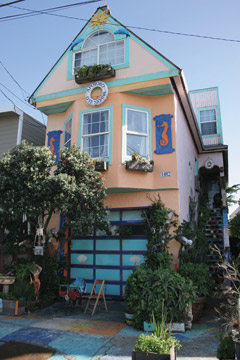 |
| Jaimal’s house in San Francisco, California |
As for the City of Ten Thousand Buddhas, I still occasionally attend retreats there; it’s a bit like jumping in an ice-cold river once a year to remind myself that I’m alive. But I go to Spirit Rock and to Thich Nhat Hanh teachings, too. Rather than live in a cold monastery, I now live in San Francisco, renting a room covered in murals of Saint Francis and various sea animals. I am a freelance writer. If that job alone doesn’t qualify me as a hippie, I also wear my hair wild and use the word love frequently.
I feel as if I am studying the dharma as “authentically” as I ever have. But on occasion, I’ll comfort myself with the knowledge that I do have a little fight left in me: I still don’t own any angel books.
Thank you for subscribing to Tricycle! As a nonprofit, we depend on readers like you to keep Buddhist teachings and practices widely available.